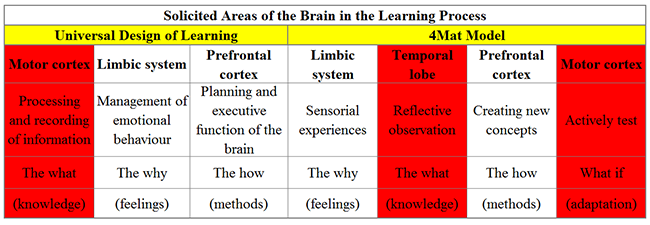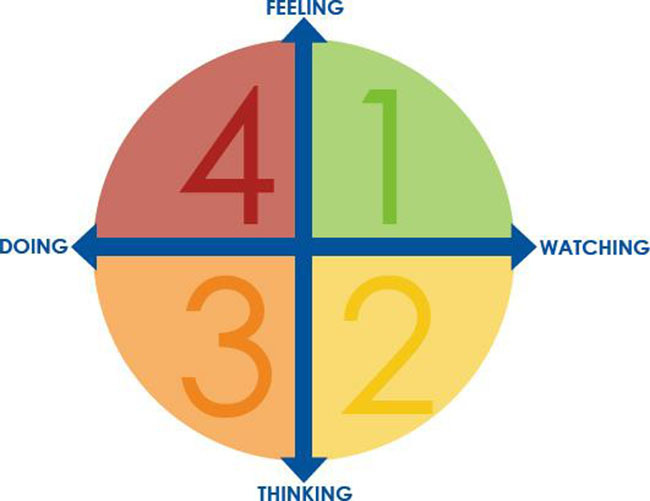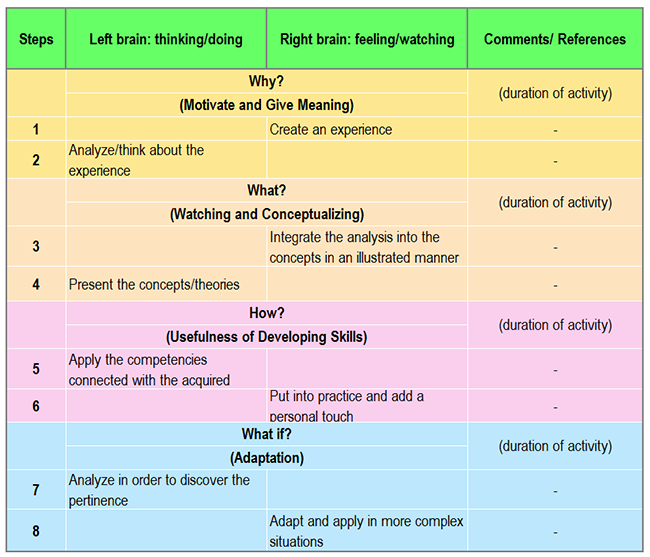4Mat, a Teaching Strategy Compatible with the Brain
You have probably heard about the Universal Design of Learning (UDL). It supposes that the human brain functions roughly the same way from one person to another, but that each person learns differently. This model therefore suggests to vary and differ pedagogical strategies in order to reach all types of learners.
In this article, I will present a model to you that is seemingly similar, that I was able to experiment with in the context of developing professional competencies. It is the model 4Mat (Four Matters), developed 30 years ago, and that aims at offering learning activities and a pedagogical sequence that takes the 4 main learning styles into account. The model 4Mat, as with UDL, can be applied to all learners, regardless of their age, because it is established from neuroscientific studies that define the role of each area of the brain in the process of learning.
A Common Base: The Founding Principles of Neuroscience
Neuroscientific research demonstrates that several spheres in the brain are involved in the learning process. Activating these areas of the brain favours both concentration and attention of all individuals, independent of the diversity of learning styles (cognitive heterogeneity) of groups. In a research study entitled: The Neuroscience of Learning: A New Paradigm for Corporate Education, published by the Maritz Institute, Ronnie Hendel-Giller and her collaborators specify that the complete learning cycle results from the structure of the brain.
The most well-known difference existing between UDL and the 4Mat model resides in the number of areas of the brain that we consider activated in the learning process.
The following table offers a comparison between the founding principles of neuroscience in the 2 models:

Comparative table of UDL and the 4Mat model.
If the 2 models agree on the roles of the limbic system and the prefrontal cortex, they differ as to the role of the temporal lobe and the motor cortex. In fact, according to the precursors of the 4Mat model:
- The temporal lobe is also involved in the learning cycle. It allows for the learner to acquire new knowledge, by reflective observation.
- The motor cortex allows the learner to develop skills in connection with learning and to go beyond this learning by adapting to more complex situations.
In the model proposed by UDL, the motor cortex completes a different function when compared to the proposed 4Mat model. This model allows for:
- Processing and recording information
- Acquiring essential knowledge, by completing the role of the temporal lobe in the 4Mat model
The Involvement of Learning Styles in the 4Mat Model
In addition to the findings of the neuroscientific research that define the role of each area of the brain in the learning process, 4Mat aims at an optimal learning experience by taking the 4 learning styles into consideration also established through neuroscientific research. The concept of learning styles is founded on the premise that each learner has a preference as to the perception and the processing of information. Some perceive information through:
- Feeling
- Watching
- Doing
- Thinking
The combination between these preferences of perception and processing of information gives the 4 quadrants (4 matters) of the model 4Mat.

The 4 quadrants of the model 4Mat (image source).
| Perception | Learning Style |
|---|---|
|
1. Feeling and watching |
People who have this learning style are directed towards observing and are interested in the value and meaning of what they are learning, the why of the subject. |
|
2. Watching and thinking |
This learning style brings together watchers and thinkers. They are interested in facts, knowledge and information from experts, the what of the subject. |
| 3. Thinking and doing | The third learning style is those who like to think and then do something. They are pushed towards hands-on activities and like applying their knowledge to the real world. they are interested in the how. |
| 4. Doing and feeling | The fourth and last learning style brings together those who are interested in the founctionning of what they have learned, the new possibilities that knowledge creates and the ways to adapt it to the real world. It is the possibilities that offer the what if that motivates them. |
Jeanine O’Neil-Blackwell, president of the company 4Mat4Business, explains these elements in a video.
Two Philosophies
While this vision of inclusion is cognitive in the 4Mat model, it is social for the precursors of UDL. In fact, in the report from CAPRES on UDL (in French only), the concept of exclusivity is clearly defined:
This concept intends to reach all learners: even if they are gifted, if they have some difficulties or if they benefit from academic adaptive measures. Inclusion, in the context of UDL, is the implementation of varied pedagogical practices striving for the success of all despite their differences.
UDL is based on the theories of brain function in the process of learning; however, it has a philosophy of accessibility to learning by those who have particular needs, whereas the underlying philosophy of 4Mat is one of accommodation to cognitive preferences, to efficiently reach adults in businesses, in the framework of training focused on competencies.
This is how the 4Mat model provides a structure to respond to the needs of learners and to their preferences while guiding them through the cycle, allowing them to transfer their knowledge. It’s about:
- Engaging the learner by creating a new experience that captures the attention of the learner and generates intrigue, a type of curiosity regarding what will be taught.
- Sharing knowledge that will be the subject of application in the real world.
- Moving to a practical phase by placing the learner in a situation of applying all of the shared information during the second phase of the cycle.
- Bringing learners to think about barriers that could emerge and how to adapt and refine what they have learned so that they can put this knowledge to use the real world.

The roles of the teacher in the process of learning (image source).
As the image above illustrates, the role of the teacher varies depending on which phase of the process he/she is in:
- In the beginning of the learning process, the teacher plays the role of facilitator.
- In the second step, he/she wears the hat of the expert in the subject matter.
- In the practical phase of the learning process, he/she uses the role of coach or mentor.
- Finally, the teacher plays the role of evaluator in the final process.
This document, created by Dalene Mactier, a passionate trainer of teaching focused on the learner, will allow you to further in the various roles of the teacher for each of the steps of the learning cycle.
This vision of the learning process coincides well with that explained in the document Le cheminement vers la compétence published by the Ministry of Education, Leisure and Sports of Quebec (2004), which describes the steps that a learner covers, from knowledge to competency, which are:
- Exploration
- Learning the basics
- Integration training
- Transfer
- Enrichment
This is a fundamental process of which the design of teaching must take it into consideration, because it is the common thread.
How to Apply the 4Mat Model?
Concretely, to apply this method in the context of teaching, I would use a simple tool, which would allow me to both:
- Carry out the learning cycle completely
- Consider the different learning styles of the audience
I am providing a plan for the development of a teaching activity.

Conclusion
The Universal Design of Learning (UDL) and the 4Mat model advocate for inclusive pedagogy that aim respectively at taking into consideration social differences and cognitive preferences in the design of teaching.
Blockquote: Even if they are different in many aspects, essentially, UDL and 4Mat promote the diversification of methods of presenting information to learners in order to reach each and everyone in particular, independent of the factors that make them different.
4Mat is perfectly linked to competency-based learning which has been used in colleges for close to 10 years. By using the model 4Mat in the design of teaching, the learner progresses naturally between the steps allowing him/her to move from learning to achieving the competency.

